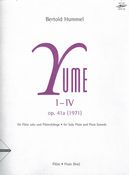Yume I-IV for Solo Flute and Flute Sounds (CD) (1971)

II.
III.
IV.
First
performance: May 11, 1971, Würzburg, Bayerisches Staatskonservatorium
für Musik
Werner Berndsen
Dennette Derby-McDermott

Duration: 11 Minutes
Publisher: Schott Music ADV 8501 / ISMN: 979-0-2063-0209-1 (Score with CD)In the Newly-Published Music Competition 1996 of the National Flute Association, the edition was awarded 1st prize.
![]() The performance CD contains
manipulated flute sounds and a complete listening version.
The performance CD contains
manipulated flute sounds and a complete listening version.
Video: Works by Hummel on youtube
The
work Yume I-IV, composed in 1971 at the instigation of my colleague
Werner Berndsen, took its title from the Japanese word "Yume", meaning
"Dreams".
In four sections, the "live" solo flute hears
a tape which contains sounds, melodies, rhythms and noises produced only by instruments
of the flute family (piccolo, great flute, alto flute). These taped events are
however transmuted by all kinds of manipulation such as double and half speed,
backwards play, echo effects, etc.
Yume I - The melodic shapes
played by the live solo flute - accompanied by gong-like sounds - weave more and
more closely together into a cadenza, the tension then being released again towards
the end.
Yume II - relentless series of movements lead to a
"manikin" impression - pleasurable rather than threatening.
Yume
III - Lines developed from a three-tone motif by the live solo flute dominate
this very tranquil section
Yume IV - Above polymetrical, percussion-like
layers, a two-part canon is played on different sound levels, fading away in an
extreme pp.
Bertold Hummel

Notes on the realisation of the manipulated flute sounds
"Yume"
("Dream visions") was composed in March and April, 1971 and received
its first performance in Würzburg in May with Werner Berndsen. The tape played
to the live solo flute (alto and great flute) uses exclusively sounds produced
by flutes, in forms which are not possible in live playing and thus could not
be replaced by a number of musicians - which justifies the procedure. The tape
sounds are produced only by changes of speed, by excessive amplification and by
use of echo effects. By slowing down or speeding up the tape, sounds are produced
ranging from G to a#''''', even to a#'''''' in the second movement (reaching however
the limits of tape recording technique).
The score was conceived by the composer
for the solo flute and 4 to 5 recorded flutes. In the 29th bar of the first movement,
a cascade-like superimposition results in even 10-part writing for the recorded
tape. The score is in conventional notation and each nuance is specified with
utmost precision. There is no improvisation in the plan. Here are the additional
"instructions" for the different movements.
1st movement:
gong-like sounds / glissandos / pads alone / flutter tonguing / echo.
2nd
movement: speeded-up tape / tritone glissando / glissando ½, 1,
1½ tone / playback of individual passages in double tempo and also backwards
in crab.
3rd movement: click effect (tongue clicking with flute
in playing position) / glissando produced by introducing thumb into the head-piece.
/ tremolo with all pads / blowing into the mouthpiece, all the air passing into
the tube (cat's hissing) / glissando (over a minor seventh) / merging in of particular
passages in double speed / flageolet and glissando for the solo flute.
4th
movement: pad percussion effect / click effect / tremolo / copy of the
solo flute in canon with echo / cymbal effect / flutter-tonguing / flutter-tonguing
and trills / glissando (tritone).
Thomas Richter
Press
TIBIA 2/98
The 1992 edition
of Advance Music includes a CD on which are recorded the complete work and also
the flute sounds without solo flute, as used on the tape accompanying the live
performer.
Electronic manipulation produces unexpected flute sounds (..)
These most colourful effects are all part of a carefully planned structure, a
distinguishing feature of all Bertold Hummel's compositions. (...) Player and
listener alike are impressed by the pleasing playability of this work, despite
its complexity.
In the new works competition of the U.S. National Flute Association
in 1966, it received the 1st prize.
Hanauer Anzeiger, 25th July, 1997
Esther Alt set the atmosphere for the evening with Bertold Hummel's Yume I/II (1971). Faced with the huge spectrum of taped flute effects with mega pad-sounds and deep, resonant bass notes, the performer made her entrance effortlessly and achieved a rare synthesis of electronics and acoustic sound, a transparent picture of "pure" flute such as the old master Hummel wished for and saw realised in this interpretation.
Ostfriesische Nachrichten, 30th July, 1996
This work was equally astonishing and fascinating. There were notes, sounds, scales recorded from different flutes, sometimes transformed to the limits of recognisability, changed into rhythms or clusters. In the dialogue with the live flute, fantastic effects arise, correspondences are felt, new horizons are opened. Jens Becker was an ideal choice as performer. He presented the work, which, incidentally, won a coveted prize in the USA, with great seriousness and ability, filled it with life and exploited both the tension and the serenity implicit in the composition.